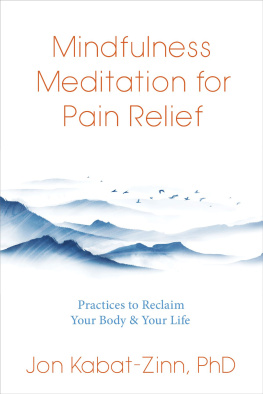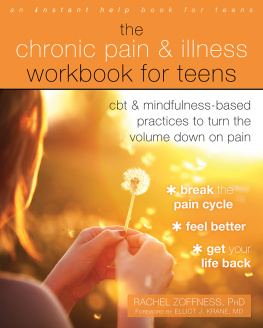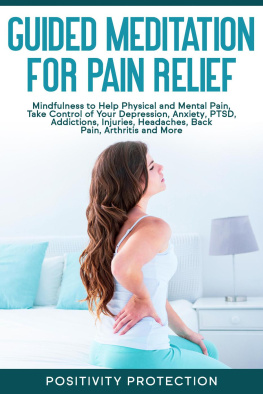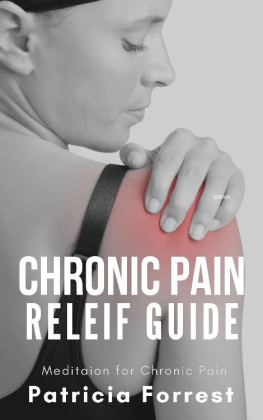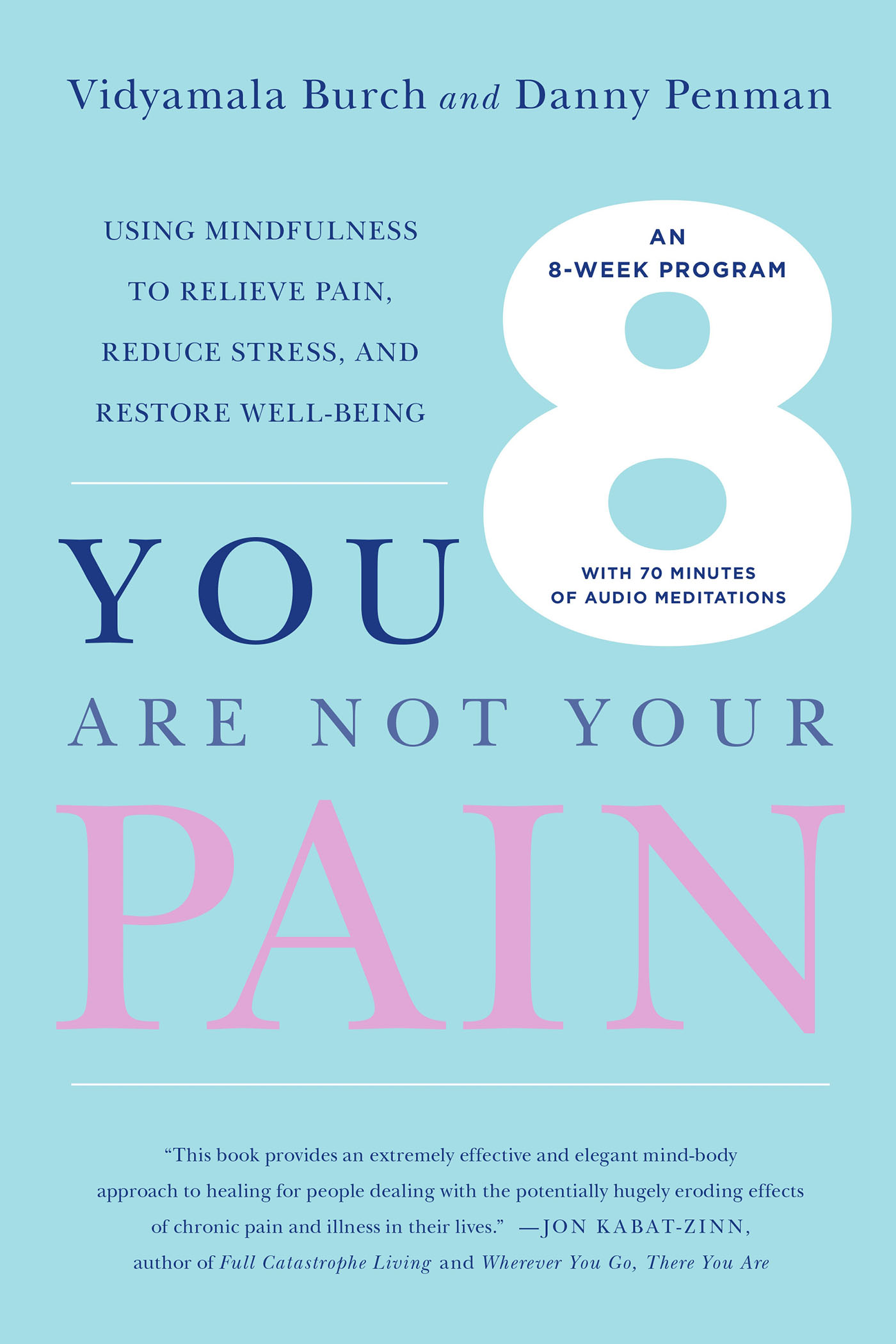Contents
Guide

The author and publisher have provided this e-book to you for your personal use only. You may not make this e-book publicly available in any way. Copyright infringement is against the law. If you believe the copy of this e-book you are reading infringes on the authors copyright, please notify the publisher at:
us.macmillanusa.com/piracy.
Please take responsibility for your own body. Seek advice from your health professional if you have doubts about any aspect of the program. If you already have a physiotherapy or exercise plan that works for you, then keep doing it alongside this one. Meditation is not a substitute for medication. Please do not alter any of the medicines that you take without first consulting your health professional. You may well find that you can reduce your dose, but make sure this is done gradually and is well managed. Even if you find you cant reduce your medication, mindfulness will still help you to get your life back on track by bringing a new richness and texture to your days.
There are a variety of ways you can support your learning when completing the course in this book. Through Breathworks, you can do it in a group with others or join an online group. Individual tuition and support are also available (for more details and a list of accredited Breathworks trainers, visit www.breathworks-mindfulness.org.uk).
For everyone at Breathworkswith deep gratitude for sharing my vision and making it real
VIDYAMALA
For sweet little Sasha May Penman
DANNY
Contents
This book could not have been written without a diverse network of people who generously gave their time, help, and support throughout.
We are enormously grateful to Sheila Crowley at Curtis Brown, Kristine Dahl at ICM Partners, and to our wonderful publisher, Bob Miller of Flatiron Books in New York. Vidyamala is especially grateful to the UKs Millennium Commission, which in 2001 awarded her a grant for disabled people who wished to contribute to the community. Without this initial input, the Peace of Mind project would not have been created, and Breathworks, as the project became known in 2004, would never have come into being. Special thanks must also go to Breathworks cofounders Sona Fricker and Gary Hennessey, along with the rest of the core team based in Manchester, UK: Colin Duff, Singhashri Gazmuri, Katy Driscoll, Di Kaylor, Karunavajri Morris, and Karolina Bakalarz. We are also grateful to the hundreds of trainers working worldwide who are dedicated to sharing the Breathworks message, as well as the thousands of people who are ill and living with pain who have involved themselves in Breathworks. Their courage and openness have helped us formulate the material in this book. Over the years, many of these people have generously shared their stories with us. When they are included in this book, weve changed their names to protect their privacy.
The main content of the program in this book is based on an online course written by Vidyamala and developed in conjunction with the Mindfulness Center in Sweden, founded by Dr. Ola Schenstrom.
Danny is especially grateful to Mr. Mark Jackson and his team at the Bristol Royal Infirmary, who reconstructed his leg following a paragliding accident. This incident led him to begin using mindfulness for pain relief and to speed healing.
Thanks also to our team of academic and medical advisers, all of whom have dedicated many years to helping people manage the suffering associated with chronic pain: Professor Lance McCracken of Kings College and St. Thomass NHS Foundation Trust; Professor Stephen Morley of the University of Leeds; and Dr. Amanda C. de C. Williams of University College London.
We are especially grateful to Jon Kabat-Zinn, the pioneering scientist at the University of Massachusetts Medical Center who brought mindfulness to Western health care. And, of course, a warm and grateful thanks must go to Professor Mark Williams of Oxford University, who has always been a great supporter of our work.
Thanks also to Sona, Vidyamalas partner, and to Bella, Dannys wife, who gave their tireless support. And Dannys baby daughter, Sasha May, has been an inspiration throughout.
At the heart of mindfulness training is a curious paradox. Mindfulness means awareness, yet surely when any of us are suffering from the searing physical pain that may arise with a chronic illness or traumatic injury, we seem to be too aware of our suffering. How on earth can learning to become even more aware possibly help?
Vidyamala Burch and Danny Penman explain how, in this beautiful and compassionate book. They describe how subtle processes of the mind can automatically turn up the volume on the very pain and discomfort you want to get rid of. Because these aggravating factors switch on automatically, without your awareness, the spotlight of attention is needed. If it all happens in the dark, you remain lost and alone with your pain. But if you can shine the light of attention upon your suffering, then it begins to dissolve.
But Vidyamala and Danny dont just give a clear and up-to-date scientific explanation of how this happens; they also provide a step-by-step guide to help you through your suffering. At the heart of this is a series of short meditation practices that will build your courage to enable you to move in closer to the center of the intensity, to investigate it with friendliness and curiosity, so you can begin to see more clearly where the automatic tendencies of the mind begin to take over. They show how you can discern which activities help or harm you, and how to incline the mind, which is often harsh and unforgiving, toward an openness and compassion that, strange as it may seem, dissolves much of the suffering that once seemed so inevitable.
I have been privileged to know both Vidyamala and Danny for many years. Both write from their own experience: each knows what it is like to suffer pain that seemed to them, at one time, unendurable. For Vidyamala, it was as a result of a lifting accident followed by a road traffic accident five years later; for Danny it was due to a paragliding accident. They describe these experiences in the book, and how they found themselves trapped in both acute and chronic pain from which there seemed no escape. Both found, in the cultivation of mindfulness meditation, a path to freedom from their suffering. On the basis of her experience, Vidyamala wrote Living Well with Pain and Illness and founded Breathworks, an organization to help those who suffer from chronic pain, illness, and stress. She has helped countless people through her writing and her clinical and training work. On the basis of his experience, Danny discovered Mindfulness-Based Cognitive Therapy (MBCT) and wrote about it eloquently in the bestseller Mindfulness: A Practical Guide to Finding Peace in a Frantic World a book that has helped many.
The book you hold in your hands contains many inspiring stories from people who had given up all hope, whose lives seemed irreversibly damaged by their illness, accident, or trauma. For some of those featured, the encouragement provided by the modern scientific understandings of painand the evidence that mindfulness can provide a radically new and effective approach to such sufferingmay have inspired them to participate in mindfulness classes. But while science can motivate the first move, it is less likely to sustain that motivation when things get tough. At this point the underlying philosophy of mindfulness, and of the originator of its use in the modern health-care system, Jon Kabat-Zinn, comes into its own. He has said that no matter what illnesses and injuries you are carrying, while you are still breathing, there is more right with you than wrong with you.


